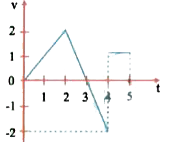The numerical ratio of displacement to the distance covered is always
less than one
equal to one
equal to or less than one
equal to or greater than one
The correct Answer is:C
To solve the question regarding the numerical ratio of displacement to the distance covered, we can follow these steps:
1. Understanding Displacement and Distance:
- Displacement is defined as the shortest straight-line distance from the initial position to the final position, along with the direction.
- Distance, on the other hand, is the total path length traveled by an object, regardless of the direction.
2. Analyzing Different Scenarios:
- Straight Line Path: If an object moves in a straight line from point A to point B, the distance covered is equal to the displacement. Therefore, the ratio of displacement to distance is:
Ratio=DisplacementDistance=dd=1
- Curved Path: If the object moves along a curved path from A to B, the distance covered will be greater than the displacement. In this case, the ratio becomes:
Ratio=DisplacementDistance<1
- Returning to the Starting Point: If the object moves from A to B and then back to A (like moving around a circle), the total distance covered is the circumference of the circle, but the displacement is zero (as the initial and final positions are the same). Thus:
Ratio=0Distance=0
3. Conclusion:
- From the above scenarios, we can conclude that the numerical ratio of displacement to distance can take values between 0 and 1, inclusive. It can be equal to 1 when the path is straight, less than 1 for curved paths, and equal to 0 when returning to the starting point.
Final Answer
The numerical ratio of displacement to the distance covered is always less than or equal to 1.
---
- Displacement is defined as the shortest straight-line distance from the initial position to the final position, along with the direction.
- Distance, on the other hand, is the total path length traveled by an object, regardless of the direction.
- Straight Line Path: If an object moves in a straight line from point A to point B, the distance covered is equal to the displacement. Therefore, the ratio of displacement to distance is:
Ratio=DisplacementDistance=dd=1
Ratio=DisplacementDistance<1
Ratio=0Distance=0
- From the above scenarios, we can conclude that the numerical ratio of displacement to distance can take values between 0 and 1, inclusive. It can be equal to 1 when the path is straight, less than 1 for curved paths, and equal to 0 when returning to the starting point.
The numerical ratio of displacement to the distance covered is always less than or equal to 1.
Similar Questions
A particle is movingin circular path of radius 7 cm. Find the ratio of its displacement to the distance covered after the completion of a half
View SolutionA particle moves in a circle of radius R. In half the period of revolution its displacement is …………… and distance covered is …………... .
View Solution
Knowledge Check
- Question 1 - Select One
The numerical ratio of displacement to distance for a moving object is :
Aalways less than 1Bequal to 1 or more than 1Calways more than 1Dequal to 1 or less than 1 - Question 2 - Select One
The numerical ratio of displacement to distance for a moving object is
Aalways less than 1Bequal to 1 or more than 1,Calways more than 1,Dequal to 1 or less than 1. - Question 3 - Select One
The numerical ratio of displacement and distance for a moving object is
Aalways less than 1Balways equal to 1Calways more than 1Dequal or less than 1
The numerical ratio of displacement and distance for a moving object is
View SolutionThe velocity versus time graph of a body moving along a straight line is as shown in figure. The ratio of displacement and distance covered body in 5 second is :-
 View Solution
View SolutionThe location of a particle has changed. What can you say about the displacement and the distance covered by the particle?
View SolutionAssertion : If the displacement of the body is zero, the distance covered by it may not be zero.
Reason : Displacement is a vector quantity and distance is a scalar quantity.View SolutionA particle is moving in a uniform circular motion with radius'r' in half revolution the displacement and distance covered by the particle are
View Solution

